check engine light TOYOTA YARIS 2017 Owners Manual
[x] Cancel search | Manufacturer: TOYOTA, Model Year: 2017, Model line: YARIS, Model: TOYOTA YARIS 2017Pages: 549, PDF Size: 33.09 MB
Page 4 of 549
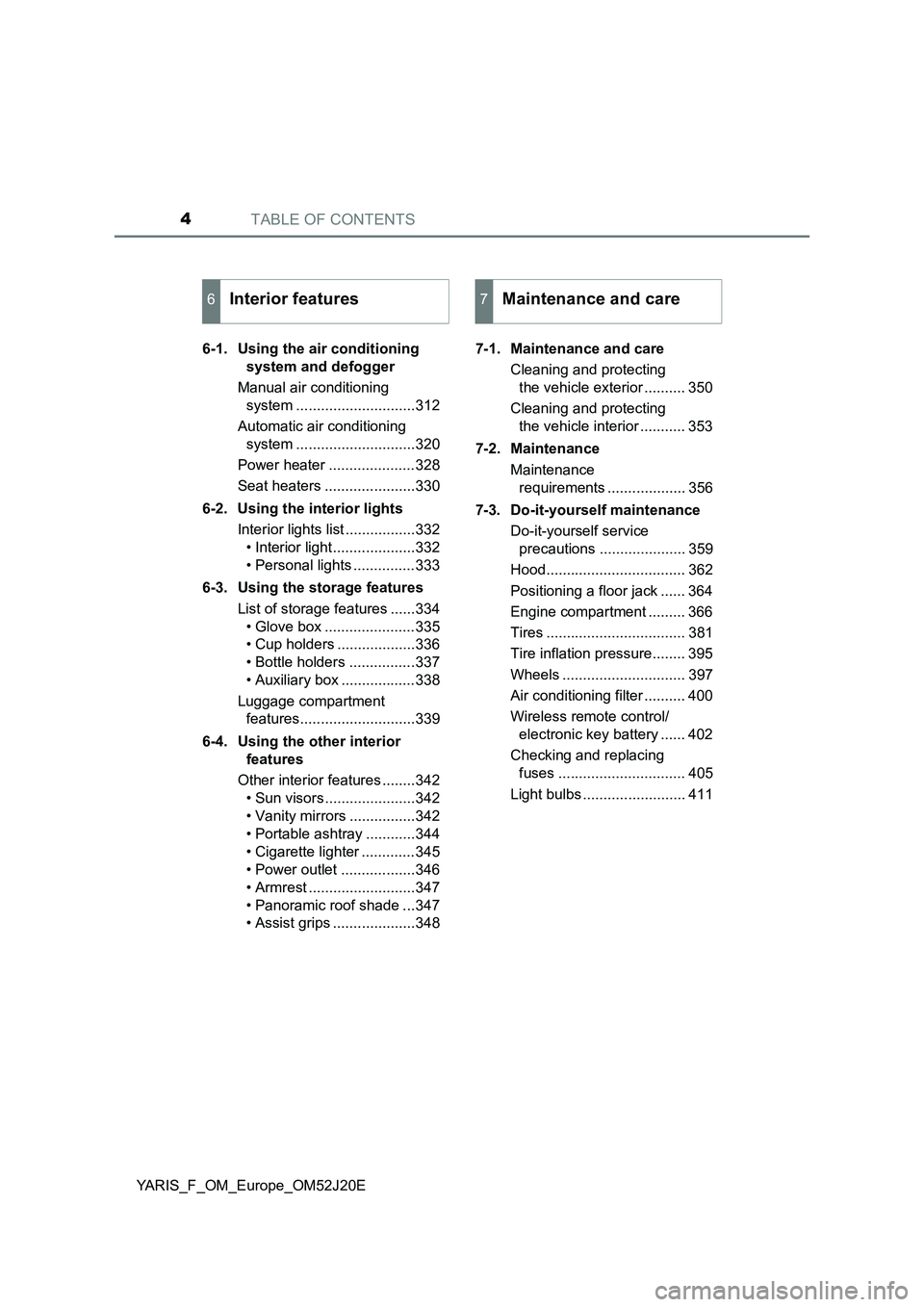
TABLE OF CONTENTS4
YARIS_F_OM_Europe_OM52J20E
6-1. Using the air conditioning
system and defogger
Manual air conditioning
system .............................312
Automatic air conditioning
system .............................320
Power heater .....................328
Seat heaters ......................330
6-2. Using the interior lights
Interior lights list .................332
• Interior light ....................332
• Personal lights ...............333
6-3. Using the storage features
List of storage features ......334
• Glove box ......................335
• Cup holders ...................336
• Bottle holders ................337
• Auxiliary box ..................338
Luggage compartment
features............................339
6-4. Using the other interior
features
Other interior features ........342
• Sun visors ......................342
• Vanity mirrors ................342
• Portable ashtray ............344
• Cigarette lighter .............345
• Power outlet ..................346
• Armrest ..........................347
• Panoramic roof shade ...347
• Assist grips ....................348
7-1. Maintenance and care
Cleaning and protecting
the vehicle exterior .......... 350
Cleaning and protecting
the vehicle interior ........... 353
7-2. Maintenance
Maintenance
requirements ................... 356
7-3. Do-it-yourself maintenance
Do-it-yourself service
precautions ..................... 359
Hood.................................. 362
Positioning a floor jack ...... 364
Engine compartment ......... 366
Tires .................................. 381
Tire inflation pressure........ 395
Wheels .............................. 397
Air conditioning filter .......... 400
Wireless remote control/
electronic key battery ...... 402
Checking and replacing
fuses ............................... 405
Light bulbs ......................... 411
6Interior features7Maintenance and care
Page 11 of 549
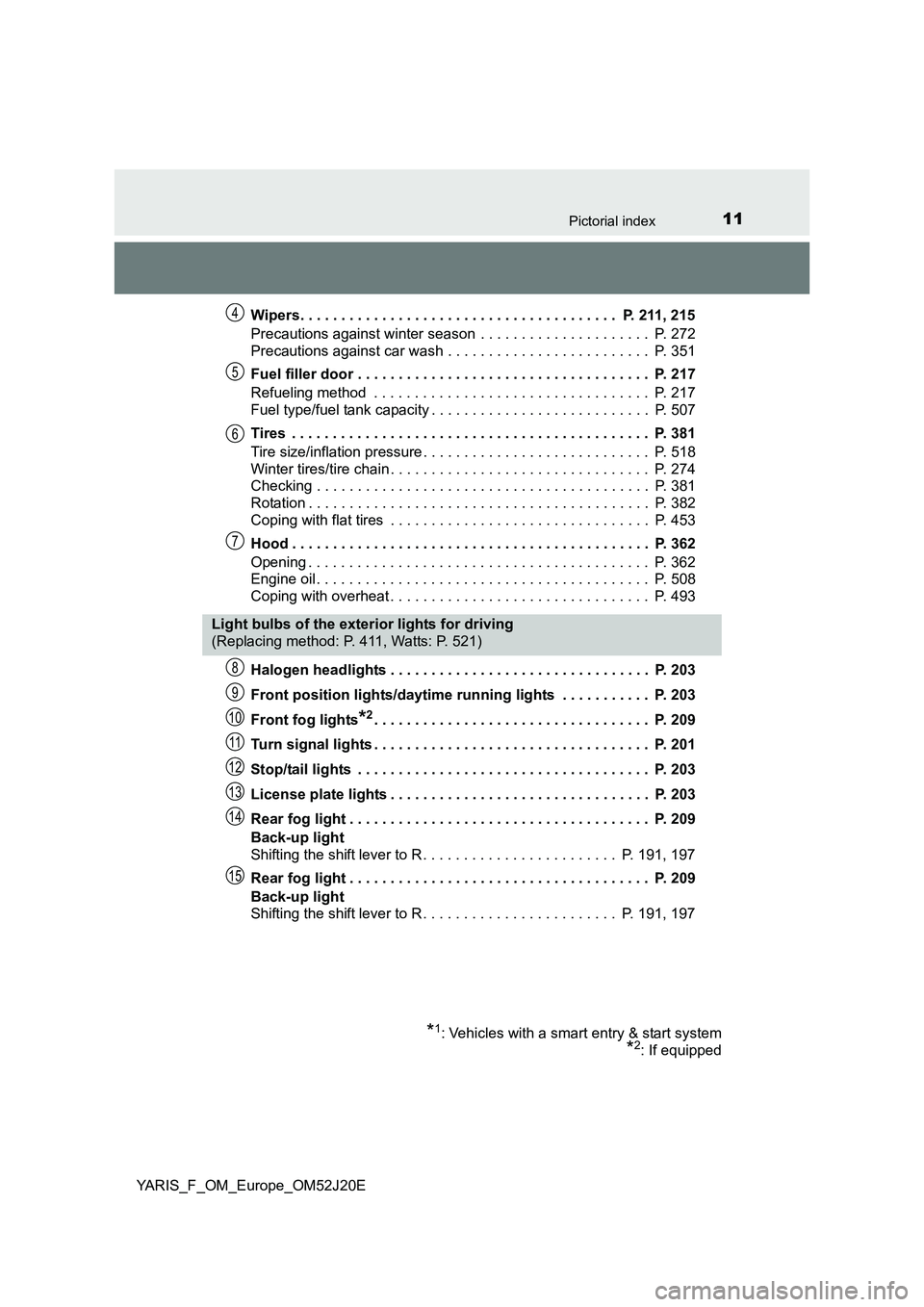
11Pictorial index
YARIS_F_OM_Europe_OM52J20E
Wipers. . . . . . . . . . . . . . . . . . . . . . . . . . . . . . . . . . . . . . . P. 211, 215
Precautions against winter season . . . . . . . . . . . . . . . . . . . . . P. 272
Precautions against car wash . . . . . . . . . . . . . . . . . . . . . . . . . P. 351
Fuel filler door . . . . . . . . . . . . . . . . . . . . . . . . . . . . . . . . . . . . P. 217
Refueling method . . . . . . . . . . . . . . . . . . . . . . . . . . . . . . . . . . P. 217
Fuel type/fuel tank capacity . . . . . . . . . . . . . . . . . . . . . . . . . . . P. 507
Tires . . . . . . . . . . . . . . . . . . . . . . . . . . . . . . . . . . . . . . . . . . . . P. 381
Tire size/inflation pressure . . . . . . . . . . . . . . . . . . . . . . . . . . . . P. 518
Winter tires/tire chain . . . . . . . . . . . . . . . . . . . . . . . . . . . . . . . . P. 274
Checking . . . . . . . . . . . . . . . . . . . . . . . . . . . . . . . . . . . . . . . . . P. 381
Rotation . . . . . . . . . . . . . . . . . . . . . . . . . . . . . . . . . . . . . . . . . . P. 382
Coping with flat tires . . . . . . . . . . . . . . . . . . . . . . . . . . . . . . . . P. 453
Hood . . . . . . . . . . . . . . . . . . . . . . . . . . . . . . . . . . . . . . . . . . . . P. 362
Opening . . . . . . . . . . . . . . . . . . . . . . . . . . . . . . . . . . . . . . . . . . P. 362
Engine oil . . . . . . . . . . . . . . . . . . . . . . . . . . . . . . . . . . . . . . . . . P. 508
Coping with overheat . . . . . . . . . . . . . . . . . . . . . . . . . . . . . . . . P. 493
Halogen headlights . . . . . . . . . . . . . . . . . . . . . . . . . . . . . . . . P. 203
Front position lights/daytime running lights . . . . . . . . . . . P. 203
Front fog lights*2. . . . . . . . . . . . . . . . . . . . . . . . . . . . . . . . . . P. 209
Turn signal lights . . . . . . . . . . . . . . . . . . . . . . . . . . . . . . . . . . P. 201
Stop/tail lights . . . . . . . . . . . . . . . . . . . . . . . . . . . . . . . . . . . . P. 203
License plate lights . . . . . . . . . . . . . . . . . . . . . . . . . . . . . . . . P. 203
Rear fog light . . . . . . . . . . . . . . . . . . . . . . . . . . . . . . . . . . . . . P. 209
Back-up light
Shifting the shift lever to R. . . . . . . . . . . . . . . . . . . . . . . . P. 191, 197
Rear fog light . . . . . . . . . . . . . . . . . . . . . . . . . . . . . . . . . . . . . P. 209
Back-up light
Shifting the shift lever to R. . . . . . . . . . . . . . . . . . . . . . . . P. 191, 197
4
5
6
7
Light bulbs of the exterior lights for driving
(Replacing method: P. 411, Watts: P. 521)
*1: Vehicles with a smart entry & start system
*2: If equipped
8
9
10
11
12
13
14
15
Page 75 of 549
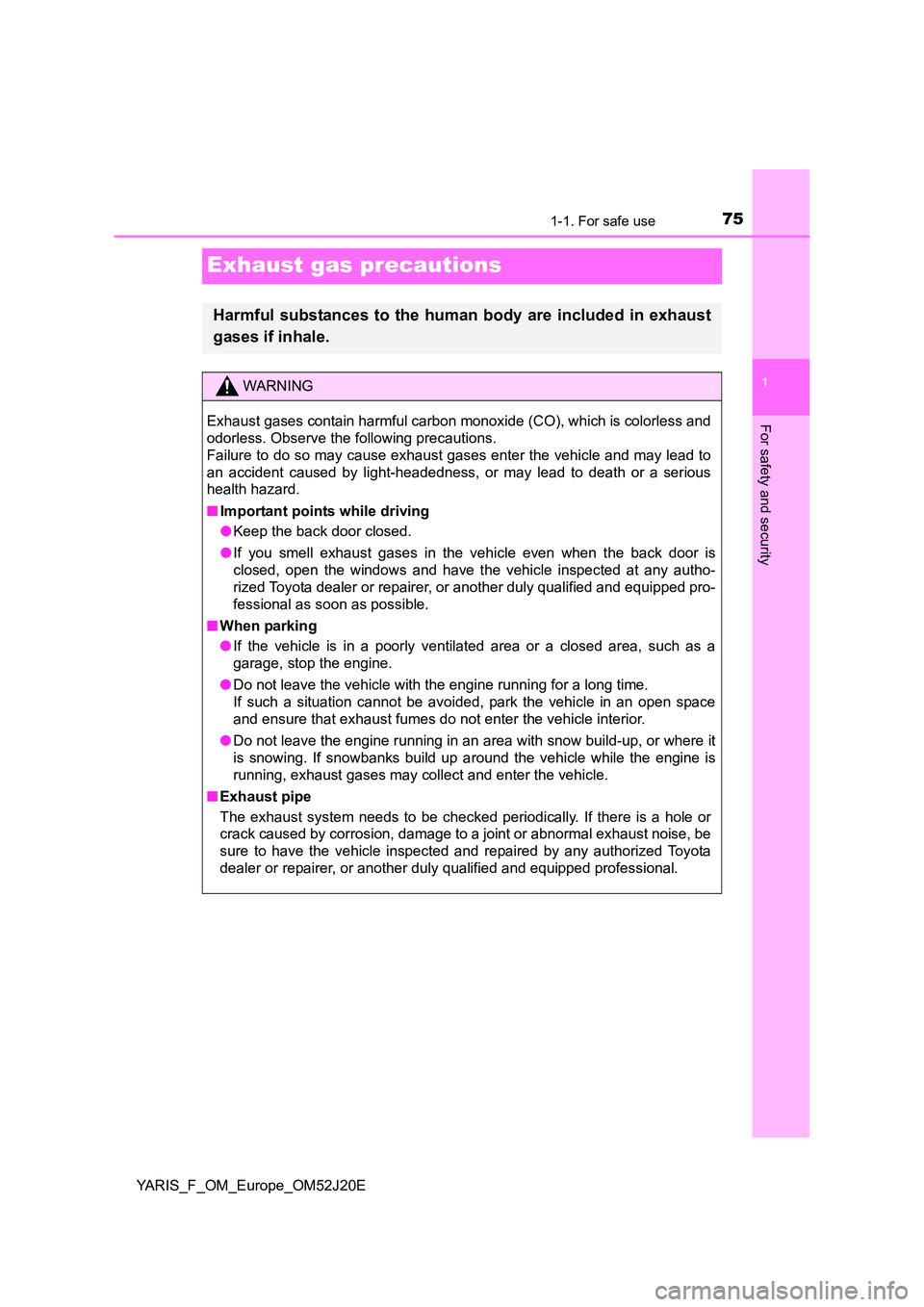
751-1. For safe use
1
For safety and security
YARIS_F_OM_Europe_OM52J20E
Exhaust gas precautions
Harmful substances to the human body are included in exhaust
gases if inhale.
WARNING
Exhaust gases contain harmful carbon monoxide (CO), which is colorless and
odorless. Observe the following precautions.
Failure to do so may cause exhaust gases enter the vehicle and may lead to
an accident caused by light-headedness, or may lead to death or a serious
health hazard.
■ Important points while driving
● Keep the back door closed.
● If you smell exhaust gases in the vehicle even when the back door is
closed, open the windows and have the vehicle inspected at any autho-
rized Toyota dealer or repairer, or another duly qualified and equipped pro-
fessional as soon as possible.
■ When parking
● If the vehicle is in a poorly ventilated area or a closed area, such as a
garage, stop the engine.
● Do not leave the vehicle with the engine running for a long time.
If such a situation cannot be avoided, park the vehicle in an open space
and ensure that exhaust fumes do not enter the vehicle interior.
● Do not leave the engine running in an area with snow build-up, or where it
is snowing. If snowbanks build up around the vehicle while the engine is
running, exhaust gases may collect and enter the vehicle.
■ Exhaust pipe
The exhaust system needs to be checked periodically. If there is a hole or
crack caused by corrosion, damage to a joint or abnormal exhaust noise, be
sure to have the vehicle inspected and repaired by any authorized Toyota
dealer or repairer, or another duly qualified and equipped professional.
Page 86 of 549
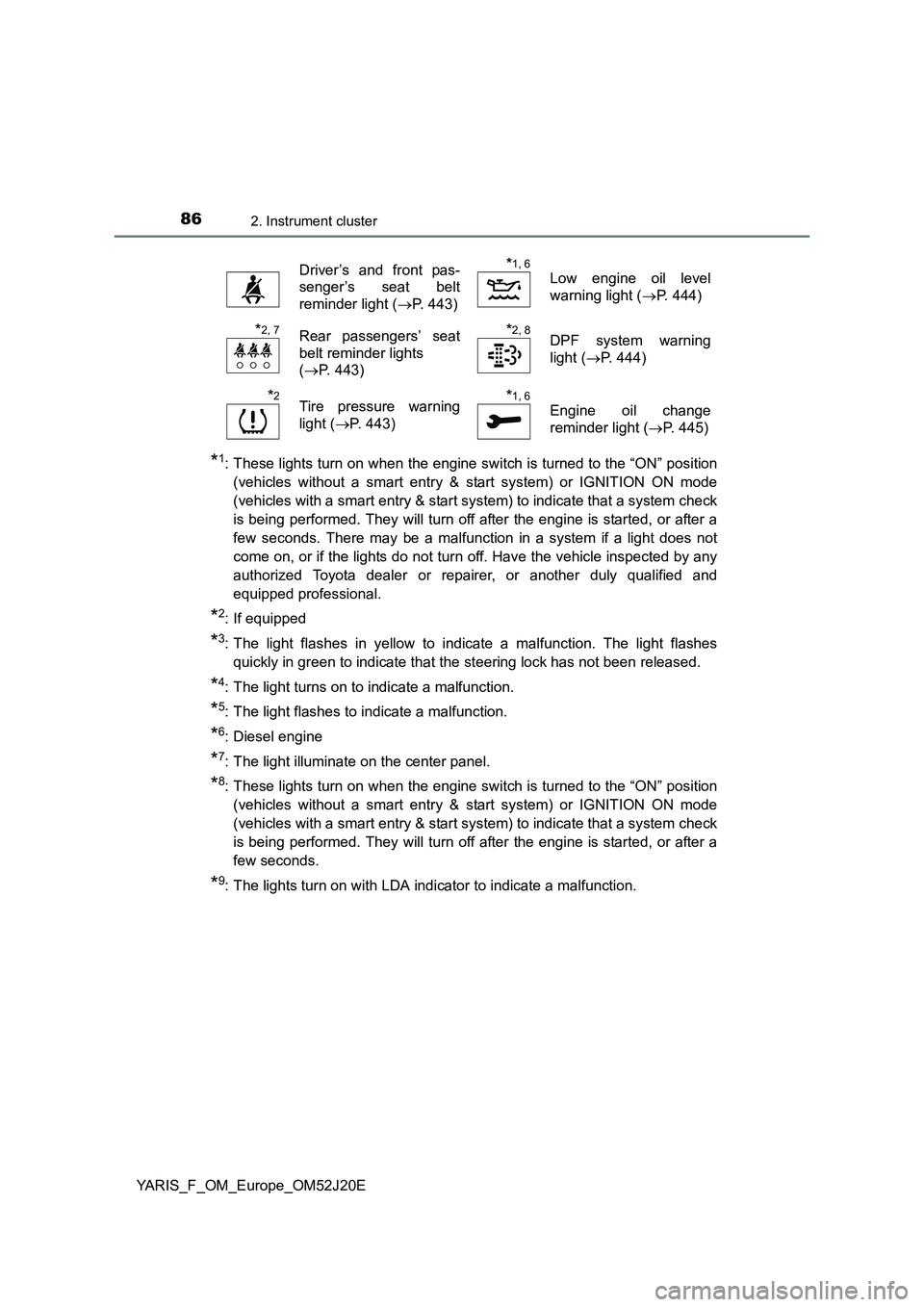
862. Instrument cluster
YARIS_F_OM_Europe_OM52J20E
*1: These lights turn on when the engine switch is turned to the “ON” position
(vehicles without a smart entry & start system) or IGNITION ON mode
(vehicles with a smart entry & start system) to indicate that a system check
is being performed. They will turn off after the engine is started, or after a
few seconds. There may be a malfunction in a system if a light does not
come on, or if the lights do not turn off. Have the vehicle inspected by any
authorized Toyota dealer or repairer, or another duly qualified and
equipped professional.
*2: If equipped
*3: The light flashes in yellow to indicate a malfunction. The light flashes
quickly in green to indicate that the steering lock has not been released.
*4: The light turns on to indicate a malfunction.
*5: The light flashes to indicate a malfunction.
*6: Diesel engine
*7: The light illuminate on the center panel.
*8: These lights turn on when the engine switch is turned to the “ON” position
(vehicles without a smart entry & start system) or IGNITION ON mode
(vehicles with a smart entry & start system) to indicate that a system check
is being performed. They will turn off after the engine is started, or after a
few seconds.
*9: The lights turn on with LDA indicator to indicate a malfunction.
Driver’s and front pas-
senger’s seat belt
reminder light ( P. 443)
*1, 6
Low engine oil level
warning light ( P. 444)
*2, 7Rear passengers’ seat
belt reminder lights
( P. 443)
*2, 8DPF system warning
light ( P. 444)
*2Tire pressure warning
light ( P. 443)
*1, 6
Engine oil change
reminder light ( P. 445)
Page 88 of 549
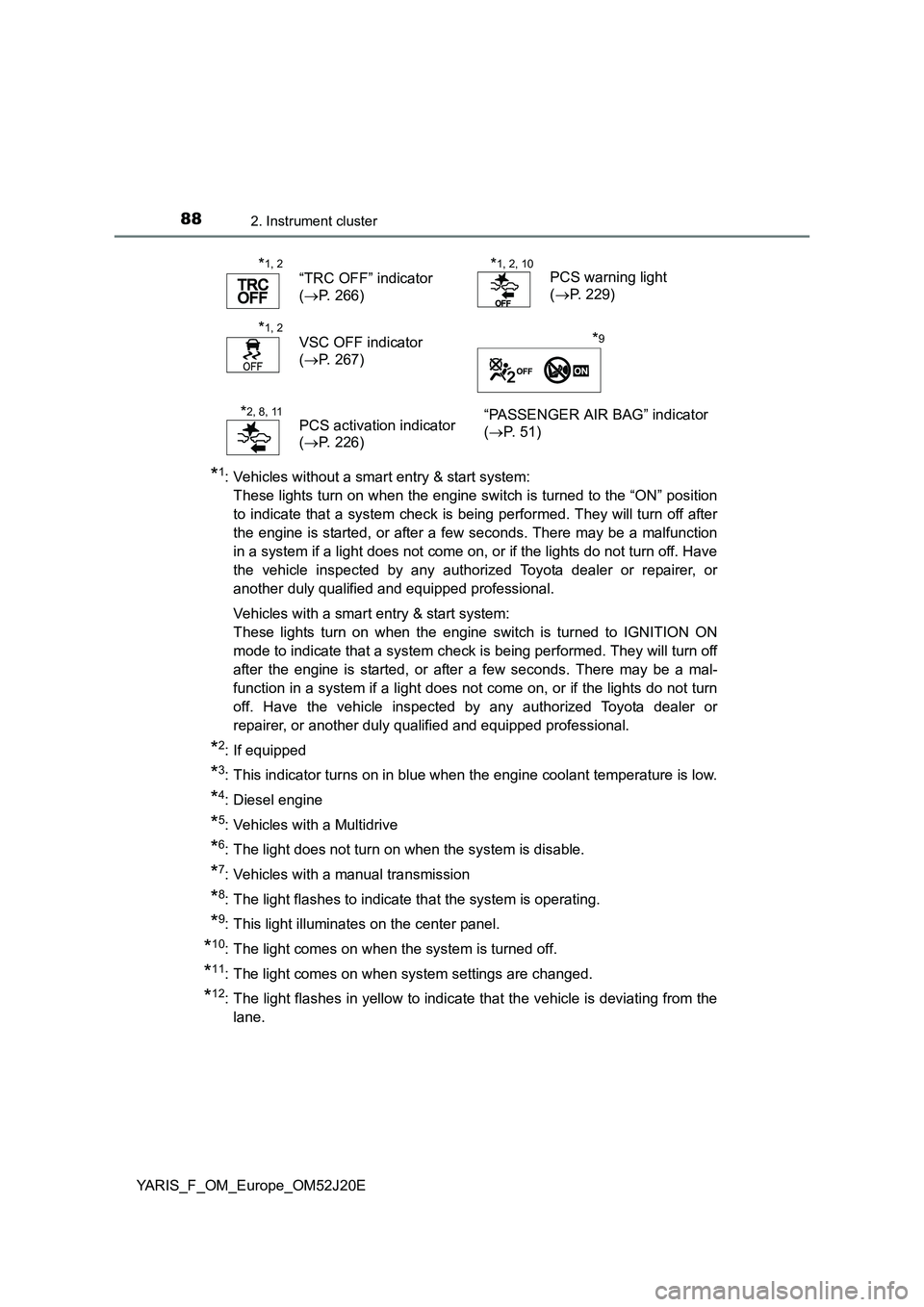
882. Instrument cluster
YARIS_F_OM_Europe_OM52J20E
*1: Vehicles without a smart entry & start system:
These lights turn on when the engine switch is turned to the “ON” position
to indicate that a system check is being performed. They will turn off after
the engine is started, or after a few seconds. There may be a malfunction
in a system if a light does not come on, or if the lights do not turn off. Have
the vehicle inspected by any authorized Toyota dealer or repairer, or
another duly qualified and equipped professional.
Vehicles with a smart entry & start system:
These lights turn on when the engine switch is turned to IGNITION ON
mode to indicate that a system check is being performed. They will turn off
after the engine is started, or after a few seconds. There may be a mal-
function in a system if a light does not come on, or if the lights do not turn
off. Have the vehicle inspected by any authorized Toyota dealer or
repairer, or another duly qualified and equipped professional.
*2: If equipped
*3: This indicator turns on in blue when the engine coolant temperature is low.
*4: Diesel engine
*5: Vehicles with a Multidrive
*6: The light does not turn on when the system is disable.
*7: Vehicles with a manual transmission
*8: The light flashes to indicate that the system is operating.
*9: This light illuminates on the center panel.
*10: The light comes on when the system is turned off.
*11: The light comes on when system settings are changed.
*12: The light flashes in yellow to indicate that the vehicle is deviating from the
lane.
*1, 2
“TRC OFF” indicator
( P. 266)
*1, 2, 10PCS warning light
( P. 229)
*1, 2
VSC OFF indicator
( P. 267)
*9
*2, 8, 11PCS activation indicator
( P. 226)
“PASSENGER AIR BAG” indicator
( P. 51)
Page 89 of 549
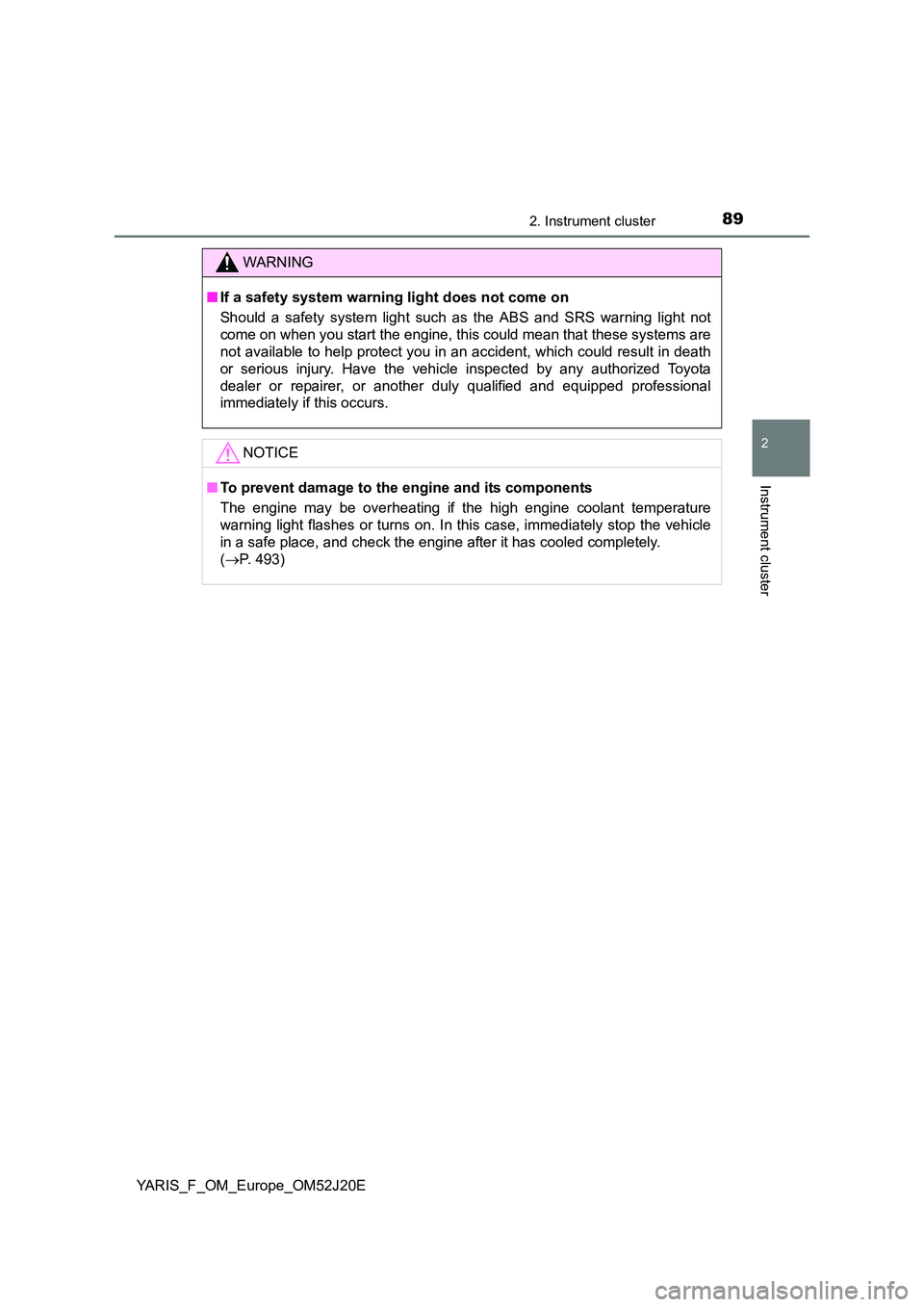
892. Instrument cluster
2
Instrument cluster
YARIS_F_OM_Europe_OM52J20E
WARNING
■If a safety system warning light does not come on
Should a safety system light such as the ABS and SRS warning light not
come on when you start the engine, this could mean that these systems are
not available to help protect you in an accident, which could result in death
or serious injury. Have the vehicle inspected by any authorized Toyota
dealer or repairer, or another duly qualified and equipped professional
immediately if this occurs.
NOTICE
■ To prevent damage to the engine and its components
The engine may be overheating if the high engine coolant temperature
warning light flashes or turns on. In this case, immediately stop the vehicle
in a safe place, and check the engine after it has cooled completely.
( P. 493)
Page 132 of 549
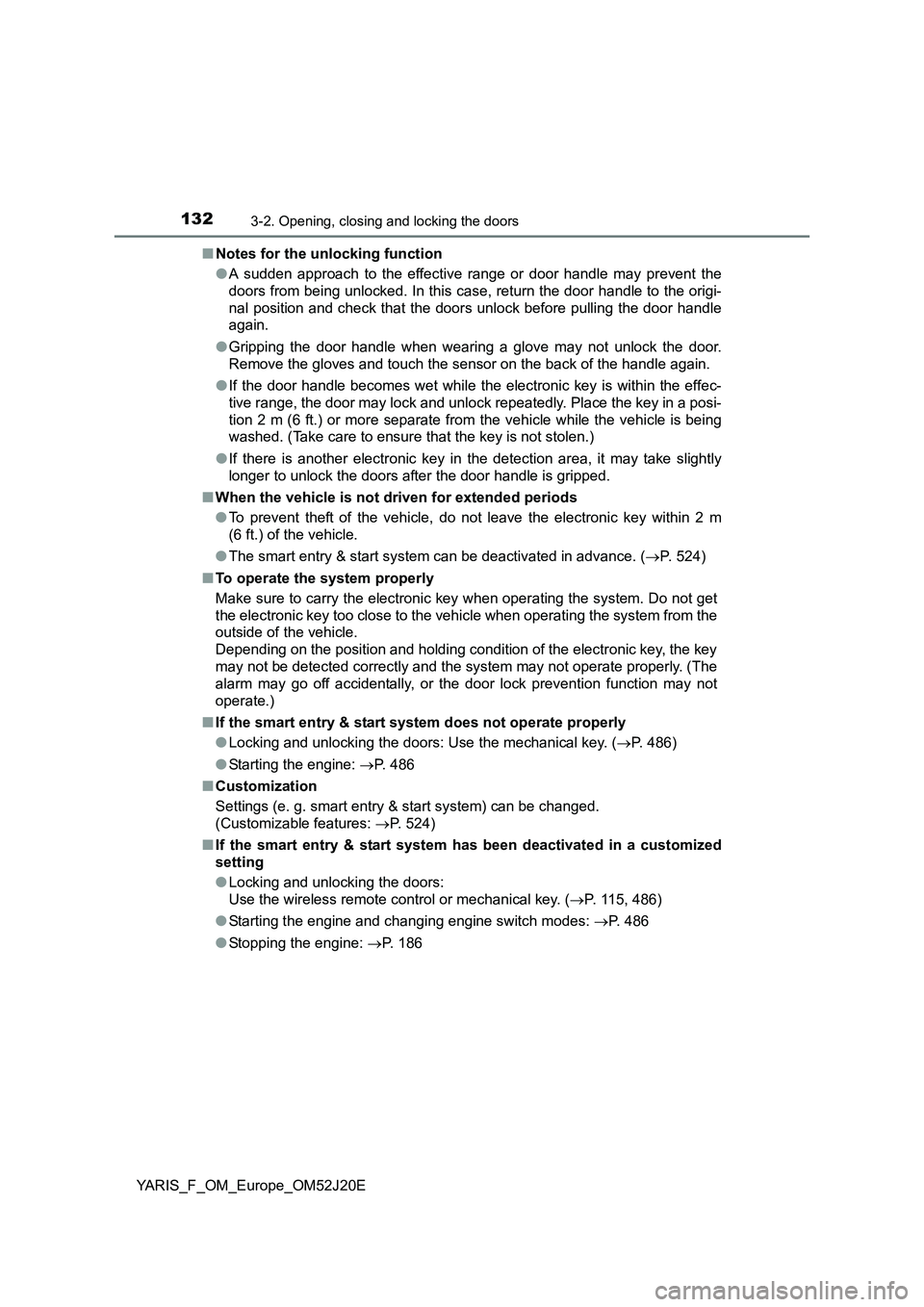
1323-2. Opening, closing and locking the doors
YARIS_F_OM_Europe_OM52J20E
■ Notes for the unlocking function
● A sudden approach to the effective range or door handle may prevent the
doors from being unlocked. In this case, return the door handle to the origi-
nal position and check that the doors unlock before pulling the door handle
again.
● Gripping the door handle when wearing a glove may not unlock the door.
Remove the gloves and touch the sensor on the back of the handle again.
● If the door handle becomes wet while the electronic key is within the effec-
tive range, the door may lock and unlock repeatedly. Place the key in a posi-
tion 2 m (6 ft.) or more separate from the vehicle while the vehicle is being
washed. (Take care to ensure that the key is not stolen.)
● If there is another electronic key in the detection area, it may take slightly
longer to unlock the doors after the door handle is gripped.
■ When the vehicle is not driven for extended periods
● To prevent theft of the vehicle, do not leave the electronic key within 2 m
(6 ft.) of the vehicle.
● The smart entry & start system can be deactivated in advance. (P. 524)
■ To operate the system properly
Make sure to carry the electronic key when operating the system. Do not get
the electronic key too close to the vehicle when operating the system from the
outside of the vehicle.
Depending on the position and holding condition of the electronic key, the key
may not be detected correctly and the system may not operate properly. (The
alarm may go off accidentally, or the door lock prevention function may not
operate.)
■ If the smart entry & start system does not operate properly
● Locking and unlocking the doors: Use the mechanical key. (P. 486)
● Starting the engine: P. 486
■ Customization
Settings (e. g. smart entry & start system) can be changed.
(Customizable features: P. 524)
■ If the smart entry & start system has been deactivated in a customized
setting
● Locking and unlocking the doors:
Use the wireless remote control or mechanical key. ( P. 115, 486)
● Starting the engine and changing engine switch modes: P. 486
● Stopping the engine: P. 186
Page 165 of 549
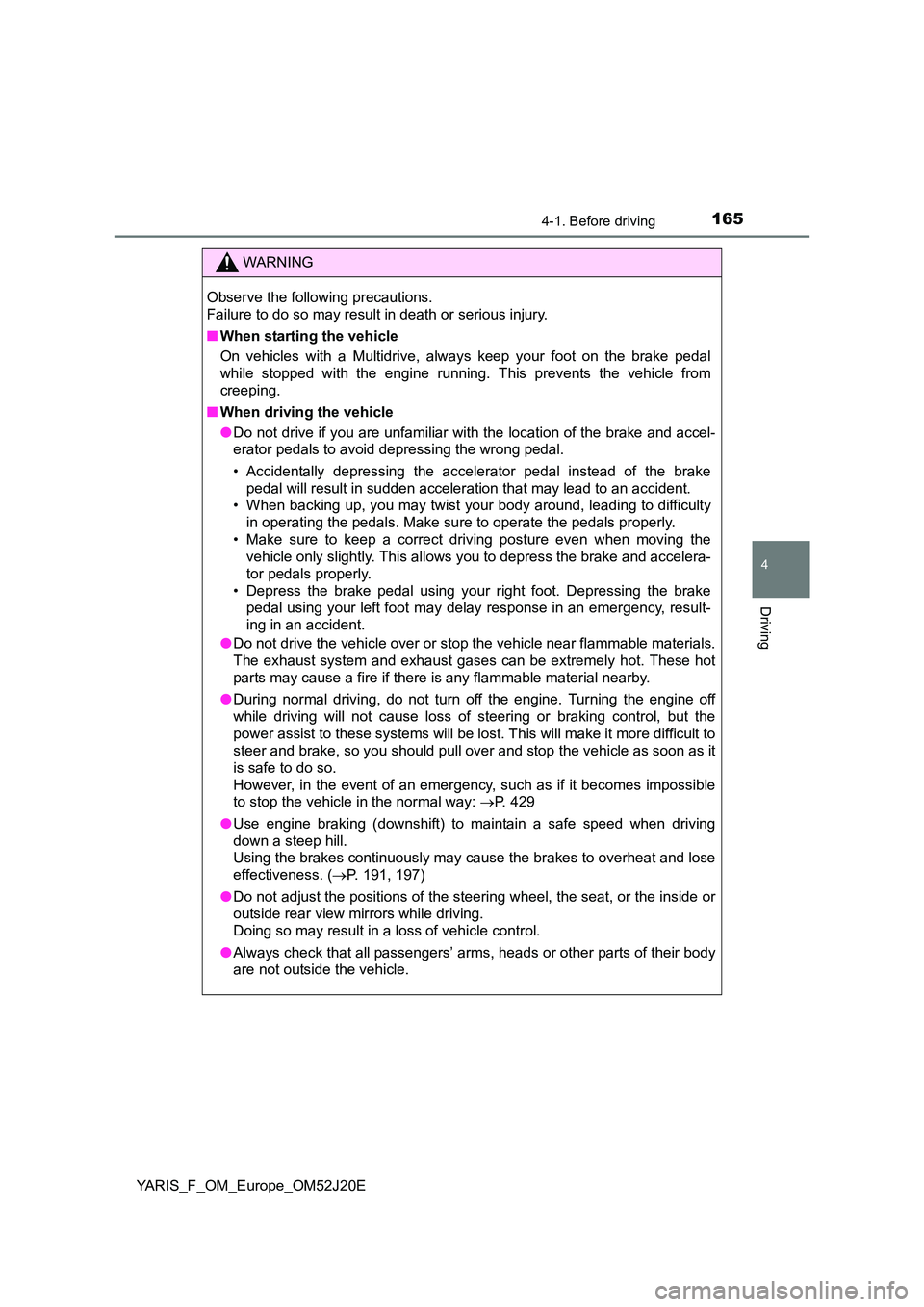
1654-1. Before driving
4
Driving
YARIS_F_OM_Europe_OM52J20E
WARNING
Observe the following precautions.
Failure to do so may result in death or serious injury.
■ When starting the vehicle
On vehicles with a Multidrive, always keep your foot on the brake pedal
while stopped with the engine running. This prevents the vehicle from
creeping.
■ When driving the vehicle
● Do not drive if you are unfamiliar with the location of the brake and accel-
erator pedals to avoid depressing the wrong pedal.
• Accidentally depressing the accelerator pedal instead of the brake
pedal will result in sudden acceleration that may lead to an accident.
• When backing up, you may twist your body around, leading to difficulty
in operating the pedals. Make su re to operate the pedals properly.
• Make sure to keep a correct driving posture even when moving the
vehicle only slightly. This allows you to depress the brake and accelera-
tor pedals properly.
• Depress the brake pedal using your right foot. Depressing the brake
pedal using your left foot may delay response in an emergency, result-
ing in an accident.
● Do not drive the vehicle over or stop the vehicle near flammable materials.
The exhaust system and exhaust gases can be extremely hot. These hot
parts may cause a fire if there is any flammable material nearby.
● During normal driving, do not turn off the engine. Turning the engine off
while driving will not cause loss of steering or braking control, but the
power assist to these systems will be lost. This will make it more difficult to
steer and brake, so you should pull over and stop the vehicle as soon as it
is safe to do so.
However, in the event of an emergency, such as if it becomes impossible
to stop the vehicle in the normal way: P. 429
● Use engine braking (downshift) to maintain a safe speed when driving
down a steep hill.
Using the brakes continuously may cause the brakes to overheat and lose
effectiveness. ( P. 191, 197)
● Do not adjust the positions of the steering wheel, the seat, or the inside or
outside rear view mirrors while driving.
Doing so may result in a loss of vehicle control.
● Always check that all passengers’ arms, heads or other parts of their body
are not outside the vehicle.
Page 167 of 549
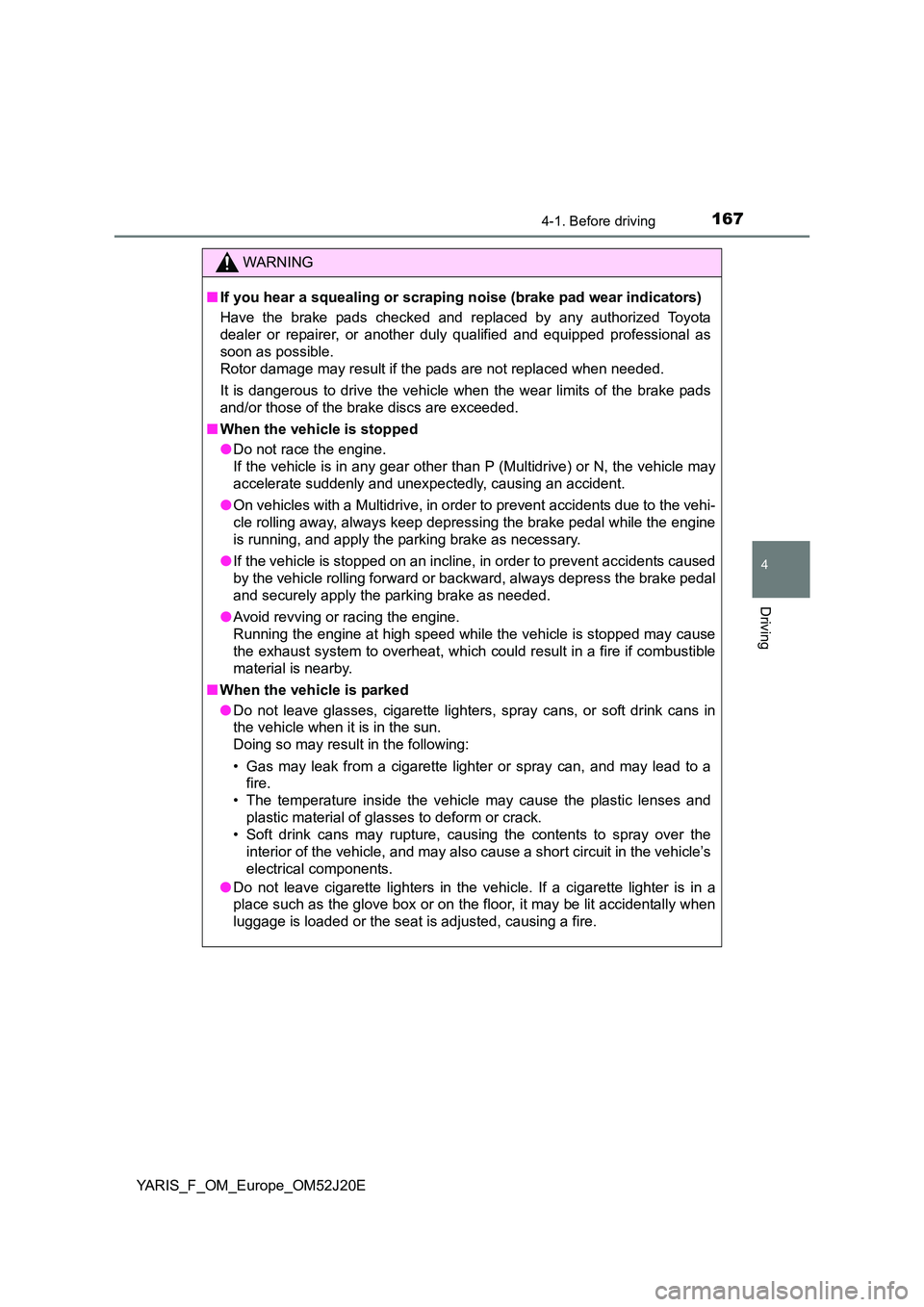
1674-1. Before driving
4
Driving
YARIS_F_OM_Europe_OM52J20E
WARNING
■If you hear a squealing or scraping noise (brake pad wear indicators)
Have the brake pads checked and replaced by any authorized Toyota
dealer or repairer, or another dul y qualified and equipped professional as
soon as possible.
Rotor damage may result if the pads are not replaced when needed.
It is dangerous to drive the vehicle when the wear limits of the brake pads
and/or those of the brake discs are exceeded.
■ When the vehicle is stopped
● Do not race the engine.
If the vehicle is in any gear other than P (Multidrive) or N, the vehicle may
accelerate suddenly and unexpectedly, causing an accident.
● On vehicles with a Multidrive, in order to prevent accidents due to the vehi-
cle rolling away, always keep depressing the brake pedal while the engine
is running, and apply the parking brake as necessary.
● If the vehicle is stopped on an incline, in order to prevent accidents caused
by the vehicle rolling forward or backward, always depress the brake pedal
and securely apply the parking brake as needed.
● Avoid revving or racing the engine.
Running the engine at high speed while the vehicle is stopped may cause
the exhaust system to overheat, which could result in a fire if combustible
material is nearby.
■ When the vehicle is parked
● Do not leave glasses, cigarette lighters, spray cans, or soft drink cans in
the vehicle when it is in the sun.
Doing so may result in the following:
• Gas may leak from a cigarette lighter or spray can, and may lead to a
fire.
• The temperature inside the vehicle may cause the plastic lenses and
plastic material of glasses to deform or crack.
• Soft drink cans may rupture, causing the contents to spray over the
interior of the vehicle, and may also cause a short circuit in the vehicle’s
electrical components.
● Do not leave cigarette lighters in the vehicle. If a cigarette lighter is in a
place such as the glove box or on the floor, it may be lit accidentally when
luggage is loaded or the seat is adjusted, causing a fire.
Page 180 of 549
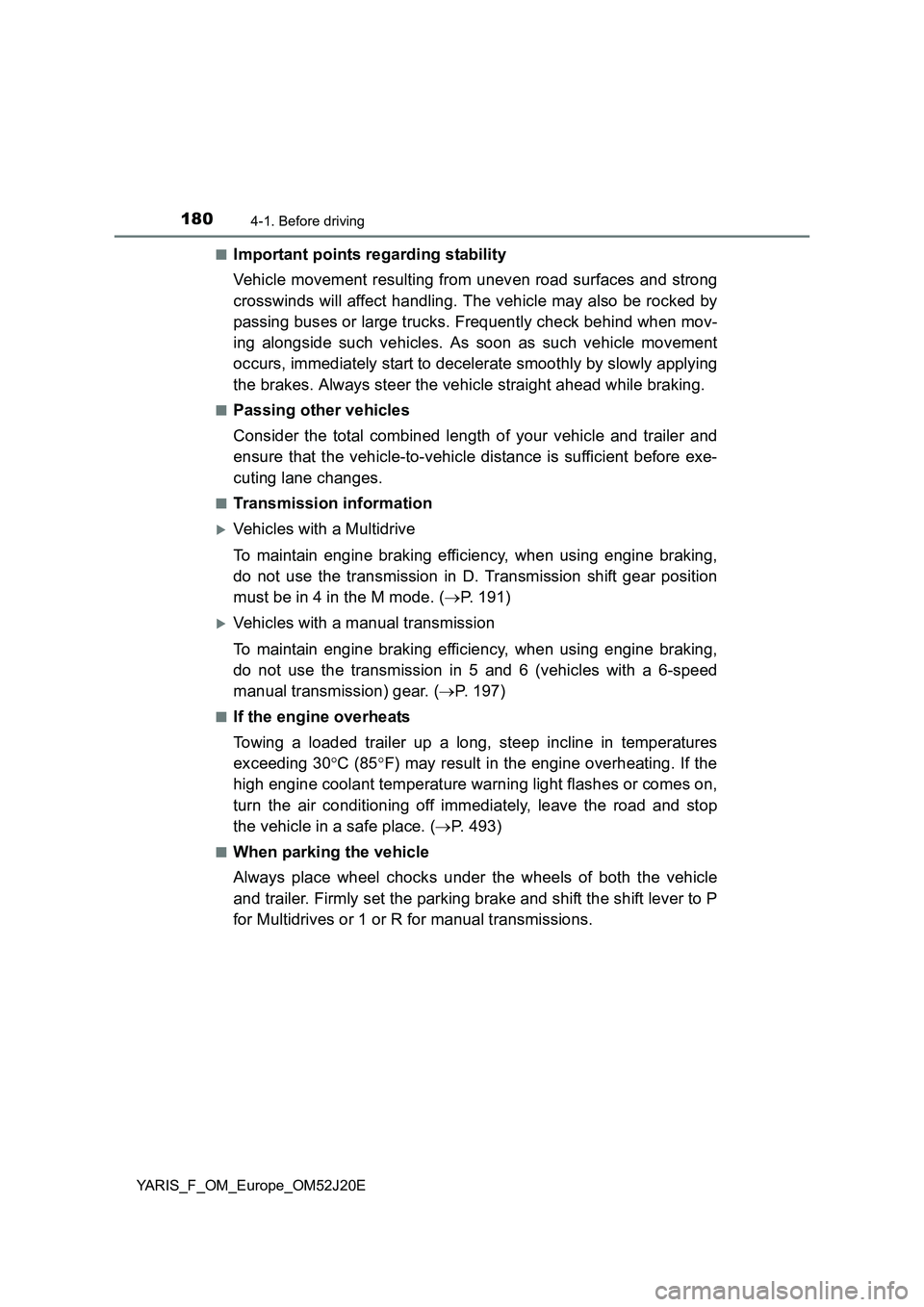
1804-1. Before driving
YARIS_F_OM_Europe_OM52J20E
■Important points regarding stability
Vehicle movement resulting from uneven road surfaces and strong
crosswinds will affect handling. The vehicle may also be rocked by
passing buses or large trucks. Frequently check behind when mov-
ing alongside such vehicles. As soon as such vehicle movement
occurs, immediately start to decelerate smoothly by slowly applying
the brakes. Always steer the vehicle straight ahead while braking.
■Passing other vehicles
Consider the total combined length of your vehicle and trailer and
ensure that the vehicle-to-vehicle distance is sufficient before exe-
cuting lane changes.
■Transmission information
Vehicles with a Multidrive
To maintain engine braking efficiency, when using engine braking,
do not use the transmission in D. Transmission shift gear position
must be in 4 in the M mode. ( P. 191)
Vehicles with a manual transmission
To maintain engine braking efficiency, when using engine braking,
do not use the transmission in 5 and 6 (vehicles with a 6-speed
manual transmission) gear. ( P. 197)
■If the engine overheats
Towing a loaded trailer up a long, steep incline in temperatures
exceeding 30 C (85F) may result in the engine overheating. If the
high engine coolant temperature warning light flashes or comes on,
turn the air conditioning off immediately, leave the road and stop
the vehicle in a safe place. ( P. 493)
■When parking the vehicle
Always place wheel chocks under the wheels of both the vehicle
and trailer. Firmly set the parking brake and shift the shift lever to P
for Multidrives or 1 or R for manual transmissions.